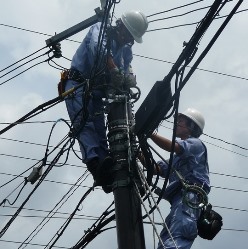How to Pick the Best Electrician Training School near Transfer Idaho
 The initial step to becoming an electrical contractor or tradesman is enrolling in an electrician trade school near Transfer ID. But with numerous vocational schools to choose from, just how do you undertake making sure that you enroll in the right one? Particularly because there are a number of points to consider. For instance, some prospective students will commence by looking for schools that are nearby their home. When they have found a few that are within commuting range, they will choose the one with the lowest tuition. While cost and location are significant, they are not the sole things that should be considered. Also critical are the reputations of the schools, their accreditation, along with their job placement and graduation rates. These and other qualifications should help mold your ultimate decision when choosing an electrician school. We will address that checklist in more detail later in this article. But to begin with, let’s review a little bit about becoming an electrician and the educational options that are available.
The initial step to becoming an electrical contractor or tradesman is enrolling in an electrician trade school near Transfer ID. But with numerous vocational schools to choose from, just how do you undertake making sure that you enroll in the right one? Particularly because there are a number of points to consider. For instance, some prospective students will commence by looking for schools that are nearby their home. When they have found a few that are within commuting range, they will choose the one with the lowest tuition. While cost and location are significant, they are not the sole things that should be considered. Also critical are the reputations of the schools, their accreditation, along with their job placement and graduation rates. These and other qualifications should help mold your ultimate decision when choosing an electrician school. We will address that checklist in more detail later in this article. But to begin with, let’s review a little bit about becoming an electrician and the educational options that are available.
Click Here to Get Free Information on Electrician Schools Near You!
Electrician Certificate, Diploma and Degree Programs
 There are three general approaches to obtain electrician training in a trade or technical school near Transfer ID. You may enroll in a diploma or certificate program, or obtain an Associate Degree. Bachelor’s Degrees are obtainable at a few schools, but are not as prevalent as the other three options. Frequently these programs are offered together with an apprenticeship, which are required by most states to become licensed or if you wish to become certified. Bellow are short explanations of the three most prevalent programs offered.
There are three general approaches to obtain electrician training in a trade or technical school near Transfer ID. You may enroll in a diploma or certificate program, or obtain an Associate Degree. Bachelor’s Degrees are obtainable at a few schools, but are not as prevalent as the other three options. Frequently these programs are offered together with an apprenticeship, which are required by most states to become licensed or if you wish to become certified. Bellow are short explanations of the three most prevalent programs offered.
- Diploma and Certificate Programs are generally offered by Idaho technical and trade schools and require approximately a year to complete. They provide a solid foundation and are aimed towards students who want to get into an apprenticeship faster as a journeyman electrician.
- Associate Degree Programs take two years to finish and are offered by Idaho community colleges, commonly as an Associate Degree in Electrical Technology. They offer a more extensive education while supplying the foundation that readies students to enter into their apprenticeship program.
As earlier mentioned, Bachelor’s Degree programs are available at some Idaho institutions, but are less preferred at 4 years than the other shorter programs. Most states mandate that an apprenticeship of at least 2 years and more typically four years be carried out prior to licensing. Because of that, most students are eager to start their paid apprenticeship, particularly if it’s not part of their educational program.
Electrician Certification and Licensing Criteria
 Electricians in Transfer ID can perform a multitude of services, including installing, replacing and testing electrical systems, and ensuring that the wiring in houses and buildings comply with code standards. After finishing an apprenticeship, journeyman electricians are mandated to become licensed in most municipalities and states. The duration of apprenticeship differs by state, but commonly about four to five years of practical experience is needed in order to take the licensing exam. The exams usually assess general knowledge and electrical theory, along with knowledge of the National Electrical Code (NEC). Obtaining certification is also a voluntary means for an electrician to differentiate her or himself as a experienced and skilled professional. The certifications offered vary by state and can be earned in numerous specialties, such as cable splicing as an example. The certification process in most cases entails three levels of competency:
Electricians in Transfer ID can perform a multitude of services, including installing, replacing and testing electrical systems, and ensuring that the wiring in houses and buildings comply with code standards. After finishing an apprenticeship, journeyman electricians are mandated to become licensed in most municipalities and states. The duration of apprenticeship differs by state, but commonly about four to five years of practical experience is needed in order to take the licensing exam. The exams usually assess general knowledge and electrical theory, along with knowledge of the National Electrical Code (NEC). Obtaining certification is also a voluntary means for an electrician to differentiate her or himself as a experienced and skilled professional. The certifications offered vary by state and can be earned in numerous specialties, such as cable splicing as an example. The certification process in most cases entails three levels of competency:
- An experience requirement
- Passing a written exam
- Passing a practical exam
Examples of certifying agencies include the National Joint Apprenticeship and Training Committee (NJATC) along with the National Institute for Certification in Engineering Technologies (NICET). It’s important that the electrician vocational school that you choose not only delivers a solid educational foundation, but also helps prepare you for passing any licensing and certification examinations that you might be required to pass in the future.
Attending Electrician Online Schools
 An option that you may have looked at is enrolling in an online electrician school to earn a certificate or degree. While online schools have become more popular as a way of attending class without the need for travel, in this case they are not completely internet based. Just about all electrician training programs require partial attendance on campus to get hands-on practical training. But since the rest of the classes may be accessed online, distance learning may be a more practical option for individuals that have limited time for schooling. And as an added benefit numerous online training programs have a reduced tuition cost compared to their on campus counterparts. Commuting costs from Transfer ID are also minimized and a portion of the study materials may be available on line as well. Each of these benefits can make online electrician vocational schools more affordable and convenient. And a number are fully accredited, which we will cover in our questions to ask checklist.
An option that you may have looked at is enrolling in an online electrician school to earn a certificate or degree. While online schools have become more popular as a way of attending class without the need for travel, in this case they are not completely internet based. Just about all electrician training programs require partial attendance on campus to get hands-on practical training. But since the rest of the classes may be accessed online, distance learning may be a more practical option for individuals that have limited time for schooling. And as an added benefit numerous online training programs have a reduced tuition cost compared to their on campus counterparts. Commuting costs from Transfer ID are also minimized and a portion of the study materials may be available on line as well. Each of these benefits can make online electrician vocational schools more affordable and convenient. And a number are fully accredited, which we will cover in our questions to ask checklist.
What to Ask Electrician Vocational Schools
 Now that you have decided to obtain a diploma, certificate or degree, you can start to focus your school options. Considering that there are so many electrician trade and vocational schools in the Transfer ID region, it’s essential to have a checklist of qualifications that each program must satisfy. The first 2 that we talked about were location and the cost of tuition. If you have an interest in earning an degree online, then that needs to be a feature that your final school offers. And even though all three qualifiers may be critical when making your selection, there are additional factors that need to be considered as well. Following is a checklist of those added qualifiers that you will need to research before selecting an electrical tech school.
Now that you have decided to obtain a diploma, certificate or degree, you can start to focus your school options. Considering that there are so many electrician trade and vocational schools in the Transfer ID region, it’s essential to have a checklist of qualifications that each program must satisfy. The first 2 that we talked about were location and the cost of tuition. If you have an interest in earning an degree online, then that needs to be a feature that your final school offers. And even though all three qualifiers may be critical when making your selection, there are additional factors that need to be considered as well. Following is a checklist of those added qualifiers that you will need to research before selecting an electrical tech school.
Accreditation. Many electrician trade schools have received either a regional or a national accreditation. They can attain Institutional Accreditation, which focuses on the school’s programs overall, or Programmatic Accreditation, which relates to an individual program, such as electrical technology. Verify that the Transfer ID school is accredited by a U.S. Department of Education acknowledged accrediting organization, which includes the Accreditation Board for Engineering and Technology. Along with helping ensure that you get a quality education, it can help in securing financial assistance or student loans, which are often unavailable for non-accredited programs. Additionally, a number of states mandate that the electrician training course be accredited in order to be approved for licensing.
High Completion and Placement Rates. Ask the electrician training programs you are considering what their completion rates are. The completion rate is the portion or percentage of students who enroll in and complete the program. A low completion rate might signify that students were unhappy with the program and quit. It might also suggest that the instructors were not qualified to instruct the students. It’s also imperative that the schools have higher job placement rates. Older and/or more reputable schools may have a more extensive list of graduates, which can mean more contacts for the school to employ for their apprenticeship and job placement programs. A high job placement rate can not only affirm that the school has a good reputation within the field, but additionally that it has the network of contacts to help Transfer ID grads acquire apprenticeships or jobs.
Apprenticeship Programs. Many electrician trade programs are taught along with an apprenticeship or an internship program. Those participating technical and vocational programs will help place you in an apprenticeship program within their network of electrician companies or trade unions. Ask if the schools you are comparing have working relationships with Transfer ID area electricians or electrical contractors. An apprenticeship not only provides a rewarding experience by providing practical training, but it also supplies employment opportunities and helps to form relationships in the regional electrician professional community.
Modern Facilities. Make sure that the campus facilities and the tools that you will be instructed on are state-of-the-art and what you will be working with in the field. If you are presently in an internship or an apprenticeship, consult with the electrical specialist you are working with regarding what you should be looking for. Otherwise, ask a local Transfer ID electrical company if they can provide some suggestions. Additionally keep in mind that unless you can move, the school must be within driving distance of your Transfer residence. Take note that if you decide to enroll in an out-of-state school, in addition to moving costs there can be higher tuition fees compared to in-state residents.
Smaller Classes. It’s important that you get as much individualized instruction as possible, which can be difficult in larger classes. Ask if you can sit in on a few of the classes so that you can see how large they are and experience the interaction between instructors and students. Speak to a few of the students and get their opinions concerning class sizes and instruction. Finally, speak to a few of the instructors and learn what their level of experience is and what certifications or degrees they hold.
Flexible Scheduling. Make sure that the class schedules for the programs you are reviewing are flexible enough to handle your needs. If you are only able to attend classes in the evening or on weekends near Transfer ID, check that the schools you are considering offer those options. If you can only attend on a part-time basis, be sure that the school you select permits part-time enrollment. Additionally, check out what the policy is to make-up classes should you miss any because of work, illness or family responsibilities.
Electrician Trade School Cost Transfer Idaho
 Picking the best electrical training program will probably be the most important decision you will make to launch your new profession. You originally came to this website due to an interest in Electrician Trade School Cost and wanting more information on the topic Learn To Be An Electrician. But as we have discussed in this article, there are several things that you will need to assess and compare between the training programs you are considering. It’s a necessity that any electrician training program that you are evaluating includes a lot of hands-on instruction. Classes should be smaller in size and every student must have their personal equipment to train with. Classroom instruction needs to offer a real-world frame of reference, and the course of study should be up-to-date and in-line with industry standards. Courses vary in duration and the kind of credential offered, so you will need to ascertain what length of program and certificate or degree will best fulfill your needs. Each training program offers unique options for certification also. Probably The ideal means to research your final list of schools is to check out each campus and speak with the teachers and students. Invest some time to sit in on a few classes. Tour the campus and facilities. Make certain that you are confident that the program you pick is the ideal one for you. With the proper training, effort and commitment, the end outcome will be a new trade as a professional electrician in Transfer ID.
Picking the best electrical training program will probably be the most important decision you will make to launch your new profession. You originally came to this website due to an interest in Electrician Trade School Cost and wanting more information on the topic Learn To Be An Electrician. But as we have discussed in this article, there are several things that you will need to assess and compare between the training programs you are considering. It’s a necessity that any electrician training program that you are evaluating includes a lot of hands-on instruction. Classes should be smaller in size and every student must have their personal equipment to train with. Classroom instruction needs to offer a real-world frame of reference, and the course of study should be up-to-date and in-line with industry standards. Courses vary in duration and the kind of credential offered, so you will need to ascertain what length of program and certificate or degree will best fulfill your needs. Each training program offers unique options for certification also. Probably The ideal means to research your final list of schools is to check out each campus and speak with the teachers and students. Invest some time to sit in on a few classes. Tour the campus and facilities. Make certain that you are confident that the program you pick is the ideal one for you. With the proper training, effort and commitment, the end outcome will be a new trade as a professional electrician in Transfer ID.
More Electric Locations in Idaho
Cell ID
In UMTS, there is a distinction between Cell ID (CID) and UTRAN Cell ID (also called LCID). The UTRAN Cell ID (LCID) is a concatenation of the RNC-ID (12 bits, ID of the Radio Network Controller) and Cell ID (16 bits, unique ID of the Cell). CID is just the Cell ID. The concatenation of both will still be unique but can be confusing in some cellid databases as some store the CID and other store LCID. It makes sense to record them separately as the RNC ID is the same for many cells, the unique element is the CID[1][2]
Business Results 1 - 10 of 2




